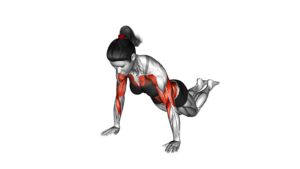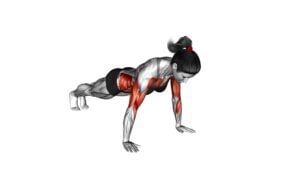Shoulder Tap (female) – Video Exercise Guide & Tips

Looking to improve your shoulder strength and stability? In this video exercise guide, we'll walk you through the proper form and technique for shoulder taps.
Watch This Exercise Video
With step-by-step instructions and helpful tips, you'll learn how to perform this effective exercise correctly.
Whether you're a beginner or more advanced, we'll also provide modifications and progressions to challenge yourself and prevent boredom.
Get ready to incorporate shoulder taps into your workout routine for stronger, more resilient shoulders.
Let's get started!
Key Takeaways
- Shoulder taps increase stability, core strength, and prevent injuries.
- They engage multiple muscle groups simultaneously, targeting the abdominal, oblique, and lower back muscles.
- Proper form and technique are crucial for maximizing the effectiveness of shoulder taps and avoiding common mistakes.
- Shoulder taps can be modified and progressed to suit different fitness levels and goals.
Benefits of Shoulder Tap Exercise
You will experience increased stability and core strength through the practice of Shoulder Tap exercises. Shoulder taps are a great way to prevent injuries and improve your overall core strength. By engaging your core muscles during this exercise, you're able to stabilize your body and maintain a strong and balanced posture. This stability is essential for preventing injuries, especially in the shoulder and upper body region.
Shoulder taps specifically target the muscles in your core, including your abdominals, obliques, and lower back. As you lift one hand to tap the opposite shoulder, your core muscles are activated to maintain balance and control. This constant engagement of your core muscles leads to increased strength and stability over time.
Not only do shoulder taps help prevent injuries, but they also contribute to improved posture and overall body control. By regularly incorporating shoulder taps into your workout routine, you can strengthen your core and enhance your body's ability to move efficiently and effectively.
In the subsequent section, we'll discuss the proper form and technique for performing shoulder taps to ensure you get the most out of this exercise and maximize its benefits for your core strength and injury prevention.
Proper Form and Technique for Shoulder Taps
To perform shoulder taps with proper form and technique, consistently engage your core muscles and maintain a strong and balanced posture. Begin by assuming a high plank position with your hands directly under your shoulders and your feet hip-width apart. Keep your body in a straight line from head to toe, avoiding any sagging or arching in your back.
From this position, lift one hand off the ground and tap it gently on the opposite shoulder, while keeping your hips and shoulders square to the floor. Return the hand to the starting position and repeat on the other side. Remember to maintain control throughout the movement and avoid any excessive twisting or rotation of your torso.
For variations of the shoulder tap exercise, you can try performing them on an unstable surface, such as a balance ball or a BOSU ball, to further challenge your core stability. Additionally, you can increase the difficulty by performing shoulder taps at a faster pace or by elevating your feet on a bench or step.
If shoulder taps are too challenging for you at the moment, there are alternative exercises that target similar muscle groups. Plank shoulder taps, mountain climbers, and bird dogs are all effective alternatives that can be incorporated into your workout routine.
Transition: Now that you have learned the proper form and technique for shoulder taps, let's explore some modifications and progressions that can help you further improve your strength and stability.
Modifications and Progressions for Shoulder Taps
To further challenge your core stability and improve your strength and stability, consider incorporating modifications and progressions into your shoulder tap exercise routine.
By making modifications to the shoulder tap exercise, you can target different muscles and intensify the workout. One modification you can try is the staggered shoulder tap, where you start in a push-up position with one hand slightly in front of the other. This variation challenges your core stability even more as you have to resist rotation.
Another modification is the single-arm shoulder tap, where you perform the exercise using only one arm. This variation increases the demand on your shoulders and core muscles.
If you're looking for more advanced shoulder tap variations, you can try the plank shoulder tap. In this exercise, you start in a high plank position and then lift one hand to tap the opposite shoulder. This variation requires even more core stability and balance as you have to resist the urge to rotate your body.
Another advanced variation is the mountain climber shoulder tap, where you perform a mountain climber exercise and then lift one hand to tap the opposite shoulder. This variation combines cardio and core strength training.
Incorporating these modifications and progressions into your shoulder tap exercise routine will help you continually challenge your muscles and improve your overall strength and stability. Remember to always maintain proper form and technique to prevent injury and get the most out of your workout.
Common Mistakes to Avoid During Shoulder Taps
One common mistake to avoid during shoulder taps is improper hand placement. When performing shoulder taps, it's important to have your hands directly underneath your shoulders, with your fingers spread wide for stability. Placing your hands too far forward or too close together can compromise your form and make the exercise less effective.
Another common mistake is sagging or arching your back. To maintain proper form, engage your core and keep your back flat throughout the movement. Avoid letting your hips sag or your lower back round, as this can put unnecessary strain on your spine.
Additionally, rushing through the exercise is a common mistake. Shoulder taps require control and stability, so it's important to perform them slowly and with intention. Take your time to tap each shoulder without rushing the movement.
Lastly, avoid excessive shoulder rotation. As you tap your shoulders, make sure to keep your shoulders and upper body stable. Excessive rotation can lead to strain or injury.
By avoiding these common mistakes and focusing on proper technique, you can maximize the benefits of shoulder taps and reduce the risk of injury.
Now let's move on to tips for incorporating shoulder taps into your workout routine.
Tips for Incorporating Shoulder Taps Into Your Workout Routine
Now let's explore how you can effectively incorporate shoulder taps into your workout routine. Here are some tips to help you make the most out of this exercise:
- Incorporate shoulder taps with other exercises: Shoulder taps can be a great addition to your upper body workout routine. You can combine them with exercises like push-ups, planks, or mountain climbers to engage your core, shoulders, and arms even more. Alternating between shoulder taps and other exercises can help increase the intensity of your workout and challenge different muscle groups.
- Try shoulder tap variations for different fitness levels: Shoulder taps can be modified to suit different fitness levels. If you're a beginner, start by performing them on an elevated surface, such as a bench or step, to reduce the amount of weight you have to support. As you progress, you can move to performing shoulder taps on the floor in a full plank position to increase the difficulty.
- Focus on proper form and technique: To get the most out of shoulder taps, it's important to maintain proper form and technique. Keep your core engaged and your body in a straight line from head to toe. Avoid excessive movement or swaying of the hips. Control your movements and tap your opposite shoulder with a light touch, ensuring stability and balance throughout the exercise.
Frequently Asked Questions
How Many Calories Can You Burn by Doing Shoulder Tap Exercises?
Shoulder tap exercises are a great way to burn calories and strengthen your upper body. By incorporating shoulder tap variations into your workout routine, you can increase the intensity and maximize calorie burn.
These exercises require core stability and engage multiple muscle groups, making them an effective calorie-burning option. The exact number of calories burned will vary depending on factors such as your weight, intensity level, and duration of the exercise.
However, incorporating shoulder tap exercises into your fitness routine can definitely contribute to your calorie-burning goals.
Can Shoulder Taps Help With Improving Posture?
Shoulder taps can be beneficial for improving posture. By engaging your core muscles, shoulder taps help to strengthen the muscles in your back, which can contribute to better posture.
Additionally, the exercise requires stability and balance, which can also help improve overall posture.
Are Shoulder Taps Suitable for People With Wrist Injuries?
Shoulder taps can be modified to accommodate people with wrist injuries. Instead of placing weight on your hands, you can perform shoulder taps by leaning against a wall or elevated surface. This modification allows you to still engage your core and improve upper body strength without straining your wrists.
Shoulder taps are beneficial for building shoulder stability, strengthening the core, and improving overall upper body strength.
Can Shoulder Taps Be Done by Beginners or Are They More Advanced Exercises?
Shoulder taps can be done by beginners as well as more advanced individuals. They're a great exercise for building core strength and stability.
If you're new to shoulder taps, start by doing them on your knees instead of your toes. This will help you develop the necessary strength and balance.
As you progress, you can gradually transition to doing shoulder taps on your toes. Remember to engage your core and maintain a stable plank position throughout the exercise.
How Often Should Shoulder Taps Be Included in a Workout Routine for Optimal Results?
To achieve optimal results, it's important to include shoulder taps in your workout routine with the right frequency.
Shoulder taps are a beneficial exercise for targeting your core and improving stability.
Aim to incorporate them into your routine at least 2-3 times a week.
This frequency allows your muscles to recover while still challenging them enough to see progress.
Remember to focus on maintaining proper form and gradually increase the intensity for the best results.
Conclusion
In conclusion, shoulder taps are a beneficial exercise for strengthening the core and improving stability. By following proper form and technique, you can maximize the effectiveness of this exercise.
Remember to start with modifications if needed and gradually progress as you become more comfortable. Avoid common mistakes such as sagging or twisting the hips.
Incorporating shoulder taps into your workout routine can enhance overall strength and fitness.

Author
Years ago, the spark of my life’s passion ignited in my mind the moment I stepped into the local gym for the first time. The inaugural bead of perspiration, the initial endeavor, the very first surge of endorphins, and a sense of pride that washed over me post-workout marked the beginning of my deep-seated interest in strength sports, fitness, and sports nutrition. This very curiosity blossomed rapidly into a profound fascination, propelling me to earn a Master’s degree in Physical Education from the Academy of Physical Education in Krakow, followed by a Sports Manager diploma from the Jagiellonian University. My journey of growth led me to gain more specialized qualifications, such as being a certified personal trainer with a focus on sports dietetics, a lifeguard, and an instructor for wellness and corrective gymnastics. Theoretical knowledge paired seamlessly with practical experience, reinforcing my belief that the transformation of individuals under my guidance was also a reflection of my personal growth. This belief holds true even today. Each day, I strive to push the boundaries and explore new realms. These realms gently elevate me to greater heights. The unique combination of passion for my field and the continuous quest for growth fuels my drive to break new ground.







